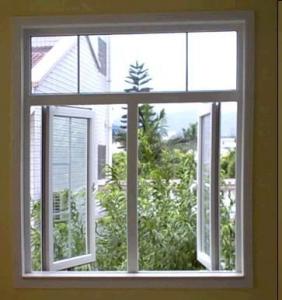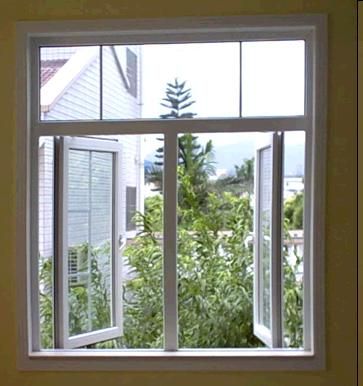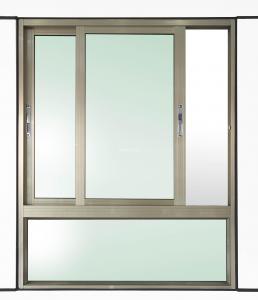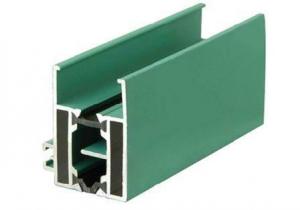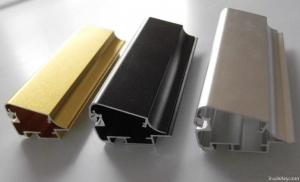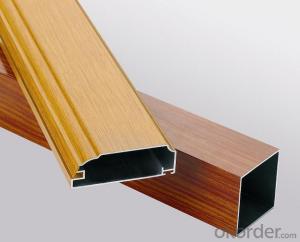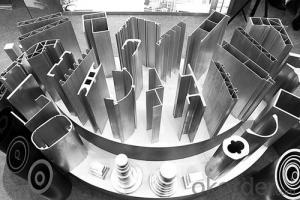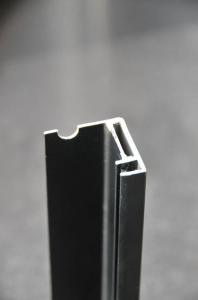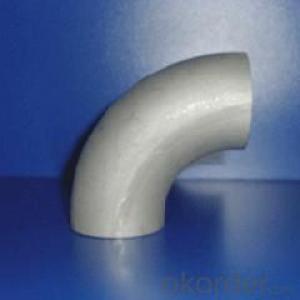Aluminum Extrusion Profiles - Aluminium Casement Window AA6063
- Loading Port:
- China Main Port
- Payment Terms:
- TT OR LC
- Min Order Qty:
- -
- Supply Capability:
- -
OKorder Service Pledge
OKorder Financial Service
You Might Also Like
Aluminum Casement Window Description
1) Aluminum window
2) Heat insulating window
3) Double glass or signle glass
Information:
1)Material : 6063 6061 6060 and different aluminium alloy
2)Status:T4 T5 T6 or other special status
3)Surface treatment: mill finish, anodized sliver ,anodized bronze, anodized champagne, anodized black pearl, various power coating color, electrostatic sliver, electrostatic champagne, electrostatic golden, electrostatic titanium , machine polish sliver, machine polish bronze, wooden grain color, and Fluorocarbon spraying.
4)Annual capacity : 120000TON
5)Quality : China Nation Standard GB/T 5237 2004 (advanced class)
6)Use: can be widely using aluminium window, door, curtain wall, hand railing , normal aluminium profile, decorative and industrial aluminium profile
7)Advantage: Famous Brand reasonable&market price, soonest delivery and good after sale- service
- Q: This question asks for methods to protect aluminum profiles from water damage during the installation and usage phases.
- <p>To prevent water damage to aluminum profiles during installation or use, follow these steps: 1. Ensure the aluminum profiles are properly sealed with a high-quality sealant to prevent water penetration. 2. Use corrosion-resistant fasteners and hardware to avoid rusting. 3. Install drainage systems to direct water away from the profiles. 4. Regularly inspect and maintain the profiles to identify and repair any damage promptly. 5. Avoid installing profiles in areas with high humidity or direct exposure to rain. 6. Use protective coatings or paints that are water-resistant and compatible with aluminum. 7. Keep the profiles clean and free from dirt or debris that can trap moisture. By following these precautions, you can significantly reduce the risk of water damage to aluminum profiles.</p>
- Q: Are aluminum profiles suitable for food processing applications?
- Yes, aluminum profiles are suitable for food processing applications. Aluminum is a lightweight and corrosion-resistant material that is widely used in the food processing industry due to its many benefits. Firstly, aluminum profiles are easy to clean and maintain, which is essential in food processing environments where hygiene is of utmost importance. They can be easily washed and sterilized to prevent any cross-contamination or bacterial growth. Secondly, aluminum is non-toxic and does not react with food or beverages, ensuring that the integrity and quality of the processed products are not compromised. This is particularly important for acidic or alkaline foods that may react with other materials. Furthermore, aluminum profiles have excellent thermal conductivity, allowing for efficient heat transfer during processing, such as in baking or cooling operations. This helps to ensure uniform heat distribution and consistent results. Additionally, aluminum is a sustainable material that can be recycled repeatedly without losing its properties. This aligns with the increasing focus on sustainability and environmental responsibility in the food processing industry. Overall, the characteristics of aluminum profiles make them a suitable choice for food processing applications, providing durability, cleanliness, and compatibility with food products.
- Q: Are aluminum profiles suitable for use in food processing environments?
- Aluminum profiles are well-suited for application in food processing environments. The food industry widely utilizes aluminum due to its exceptional properties. Its lightweight, durable, and corrosion-resistant nature makes it an ideal material for use in food processing, where cleanliness and hygiene are paramount. Cleaning and sanitizing aluminum profiles is a breeze, which is crucial for preventing contamination and ensuring food safety. Their smooth and non-porous surface inhibits bacterial growth and simplifies maintenance. Moreover, aluminum boasts excellent thermal conductivity, enabling efficient heat transfer and temperature control during food processing. This characteristic proves particularly valuable in food packaging, cooking, and chilling applications. In addition to its physical attributes, aluminum is non-toxic and does not react with food or beverages. As an inert material, it does not release any harmful substances that could contaminate the processed food. Overall, aluminum profiles are a reliable and suitable choice for food processing environments. They meet the industry's stringent requirements for hygiene, durability, and safety, making them a popular option in the food processing and packaging sectors.
- Q: What are the surface finishes available for aluminum profiles?
- Some common surface finishes available for aluminum profiles include anodizing, powder coating, polishing, brushing, and chemical etching.
- Q: Identify the key elements to evaluate when choosing aluminum profiles for a particular project.
- <p>When selecting aluminum profiles for a specific project, consider the following factors: 1) Load-bearing capacity, ensuring the profile can support the intended weight and stress; 2) Dimensional stability, to maintain structural integrity over time; 3) Corrosion resistance, especially for outdoor or humid environments; 4) Aesthetics, matching the profile's appearance with the project's design; 5) Cost-effectiveness, balancing quality with budget constraints; 6) Availability of the profile, considering lead times and supply chain reliability; 7) Ease of fabrication and assembly, which can affect construction time and labor costs; 8) Thermal properties, important for energy efficiency in buildings; 9) Compliance with industry standards and regulations; 10) Customizability, for projects with unique specifications or design requirements.</p>
- Q: What are the methods to protect aluminum profiles from corrosion in environments with harsh conditions?
- <p>To prevent corrosion of aluminum profiles in harsh environments, you can apply several protective measures. First, use anodizing, a process that forms a protective oxide layer on the surface. Second, apply a protective coating such as powder coating or painting, which can provide a barrier against corrosive elements. Third, ensure proper design to prevent water trapping and facilitate drainage. Fourth, use corrosion-resistant alloys or add corrosion inhibitors to the environment. Regular inspection and maintenance are also crucial to detect and address corrosion early.</p>
- Q: Can aluminum profiles be used in the construction of curtain walls?
- Curtain walls can indeed utilize aluminum profiles. In fact, aluminum stands as one of the most commonly employed materials for curtain wall systems due to its multitude of advantageous properties. Aluminum profiles possess the ideal combination of lightness and strength, making them perfect for constructing large and structurally sound curtain walls. Moreover, aluminum exhibits high resistance to corrosion, guaranteeing the curtain wall's longevity and durability. It also boasts exceptional versatility, easily taking on various shapes and designs to meet specific requirements and creating visually appealing curtain walls. Furthermore, aluminum profiles effortlessly accommodate different components and features, including glazing, insulation, and ventilation systems. This versatility makes them a popular choice for contemporary curtain wall designs. Additionally, using aluminum profiles enables efficient installation and maintenance processes since they can be prefabricated offsite and promptly assembled on-site. All in all, employing aluminum profiles in curtain wall construction offers numerous benefits in terms of strength, durability, versatility, and aesthetics. Consequently, many architects and builders within the construction industry prefer this material.
- Q: Whether aluminum profile of glass curtain wall needs compulsory test?
- Quality inspection standard for glass curtain wall project required2.7 quality assurance materialsFor the inspection of 2.7.1 aluminum alloy sections, the following materials should be provided:Product certification of 1. profiles.Mechanical performance test report of 2. profiles, profile should be imported by the State commodity inspection department inspection certificate.
- Q: How to identify and distinguish the inferior aluminum profile and the poor aluminum profile four?
- First, extrusion defects.Aluminum extrusion process for machine equipment is perfect, process technology is mature and whether the operation staff misconduct and other reasons, will lead to aluminum flakes, such as inclusion, delamination, chromatic aberration, distortion and other defects, affecting the quality of aluminum profiles.Second, the film thickness is thin.Industrial aluminum oxide film thickness standard should be not less than 10um (m). If the thickness is not enough, the surface of the aluminum profile is easy to rust and corrode and shorten the service life. In order to save the cost, the thickness of the oxide film is only 2 to 4um, and some even have no oxide film. It is estimated that each reduction of 1um film thickness can reduce power consumption by more than 150 yuan per ton.
- Q: What are the advantages of using aluminum profiles in the telecommunications industry?
- Aluminum profiles offer numerous benefits for the telecommunications industry. Firstly, they possess a combination of lightweight and robust qualities, making them ideal for constructing infrastructure like antenna towers and satellite dishes. Their lightweight nature facilitates easy transportation and installation, resulting in time and cost savings. Secondly, aluminum profiles boast exceptional resistance to corrosion. This property is of utmost importance in the telecommunications industry, where exposure to harsh weather conditions and corrosive elements such as saltwater is common. Aluminum profiles can withstand these conditions without deterioration, guaranteeing the longevity and reliability of telecommunication equipment. Moreover, aluminum profiles are highly adaptable and can be easily tailored to meet specific design requirements. They can be extruded into various shapes and sizes, allowing for the creation of intricate structures capable of accommodating different telecommunications equipment. This versatility streamlines the integration of various components and simplifies the installation and maintenance processes. Additionally, aluminum profiles possess excellent thermal conductivity, a crucial characteristic in the telecommunications industry. As telecommunication equipment generates heat during operation, effective heat dissipation is essential to prevent overheating and equipment failure. Aluminum profiles efficiently dissipate heat, ensuring optimal performance and prolonged lifespan of telecommunication devices. Finally, aluminum is a sustainable and environmentally friendly material. It is entirely recyclable, meaning that old or damaged aluminum profiles can be recycled and transformed into new products, thereby minimizing waste and reducing the environmental footprint. By incorporating aluminum profiles into their operations, the telecommunications industry can contribute to sustainability efforts. In summary, the advantages of utilizing aluminum profiles in the telecommunications industry encompass their lightweight yet sturdy nature, corrosion resistance, adaptability, thermal conductivity, and sustainability. These characteristics make aluminum profiles an excellent choice for constructing telecommunication infrastructure, ensuring reliable performance, and minimizing environmental impact.
Send your message to us
Aluminum Extrusion Profiles - Aluminium Casement Window AA6063
- Loading Port:
- China Main Port
- Payment Terms:
- TT OR LC
- Min Order Qty:
- -
- Supply Capability:
- -
OKorder Service Pledge
OKorder Financial Service
Similar products
Hot products
Hot Searches
Related keywords
